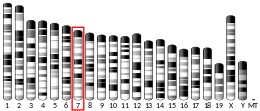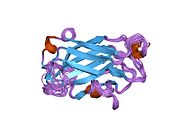XRCC1
XRCC1| XRCC1 | |||||||||||||||||||||||||
|---|---|---|---|---|---|---|---|---|---|---|---|---|---|---|---|---|---|---|---|---|---|---|---|---|---|
 | |||||||||||||||||||||||||
| |||||||||||||||||||||||||
| 식별자 | |||||||||||||||||||||||||
| 별칭 | 중국 햄스터 셀의 결함 수리를 보완하는 XRCC1, RCC, X선 수리 1, SCAR26을 보완하는 X선 수리 | ||||||||||||||||||||||||
| 외부 ID | OMIM: 194360 MGI: 99137 HomoloGene: 31368 GeneCard: XRCC1 | ||||||||||||||||||||||||
| |||||||||||||||||||||||||
| |||||||||||||||||||||||||
| |||||||||||||||||||||||||
| 직교체 | |||||||||||||||||||||||||
| 종 | 인간 | 마우스 | |||||||||||||||||||||||
| 엔트레스 | |||||||||||||||||||||||||
| 앙상블 | |||||||||||||||||||||||||
| 유니프로트 | |||||||||||||||||||||||||
| RefSeq(mRNA) | |||||||||||||||||||||||||
| RefSeq(단백질) | |||||||||||||||||||||||||
| 위치(UCSC) | Cr 19: 43.54 – 43.58Mb | Chr 7: 24.25 – 24.27Mb | |||||||||||||||||||||||
| PubMed 검색 | [3] | [4] | |||||||||||||||||||||||
| 위키다타 | |||||||||||||||||||||||||
| |||||||||||||||||||||||||
DNA수리 단백질 XRCC1은 X선수리 교차완성 단백질 1로도 알려져 있으며, 인간 내에서는 XRCC1 유전자에 의해 인코딩되는 단백질이다.XRCC1은 DNA 수리에 관여하는데, 여기서 DNA 리가세 III와 콤플렉스가 된다.
함수
| XRCC1_N | |||||||||
|---|---|---|---|---|---|---|---|---|---|
 단발성 파단 수리 단백질 xrcc1-n-mr 영역의 nmr 솔루션 구조 | |||||||||
| 식별자 | |||||||||
| 기호 | XRCC1_N | ||||||||
| Pfam | PF01834 | ||||||||
| Pfam 씨 | CL0202 | ||||||||
| 인터프로 | IPR002706 | ||||||||
| SCOP2 | 1xnt / SCOPe / SUPFAM | ||||||||
| |||||||||
XRCC1은 전리방사선 및 알킬링제 피폭에 의해 형성된 DNA 단일스트랜드의 효율적인 복구에 관여한다.이 단백질은 염기 분리 수리 경로에 참여하기 위해 DNA 리가아제 III, 중합효소 베타 및 폴리(ADP-리보스) 중합효소와 상호작용한다.그것은 감수생식, 즉 세균 세포의 감수분열과 재조합을 유도하는 동안 DNA 처리에 역할을 할 수 있다.이 유전자에 있는 희귀한 미세 위성 다형성은 방사선에 대한 민감도가 다양한 환자의 암과 관련이 있다.[5]
XRCC1 단백질은 효소 활성을 가지지는 않지만 복수의 보수 효소와 상호작용하는 비계 단백질 역할을 한다.비계는 이러한 수리 효소가 DNA를 수리하는 효소 단계를 수행할 수 있도록 한다. XRCC1은 단일 스트랜드 파손 수리, 베이스 절개 수리, 뉴클레오티드 절개 수리에 관여한다.[6]
런던이 검토한 바와 같이 [6]XRCC1 단백질은 ~150개 및 120개 잔류물의 두 개의 링커 세그먼트에 의해 연결된 3개의 구상 영역을 가지고 있다.XRCC1 N-단자 도메인은 DNA 중합효소 베타, C-단자 BRCT 도메인은 DNA 리가세 III 알파와 상호 작용하며 중앙 도메인에는 폴리(ADP-리보스) 결합 모티브가 있다.이 중앙 도메인은 PARP1이 단일 Strand Break에 바인딩된 후 PARP1에서 형성되는 고분자 ADP-리보스에 XRCC1을 모집할 수 있다.첫 번째 링커는 핵 국산화 시퀀스를 포함하고 있으며 DNA 수리 단백질 REV1과 상호작용하는 부위가 있으며, REV1은 트랜슬리온 중합체를 모집한다.두 번째 링커는 폴리뉴클레오티드 키나아제 인산염(PNKP) (기초절제 수리 중 DNA가 깨진 끝을 처리하는), Aprataxin (단일 가닥 DNA 수리 및 비호몰성 엔드 결합에서 활성) 및 세 번째 단백질 지정 Aprataxin- 및 PNKP 유사 인자와 상호작용한다.
XRCC1은 이중 가닥 파손의 미생물 매개 결합(MMEJ) 수리에 필수적인 역할을 한다.MMEJ는 오류 발생 가능성이 매우 높은 DNA 수리 경로로, 삭제 돌연변이를 초래한다.XRCC1은 이 경로에 필요한 6개의 단백질 중 하나이다.[7]
암에서의 과잉 표현
XRCC1은 비소세포폐암(NSCLC)에서 과하게 발현되며 [8]NSCLC의 전이성 림프절에서 훨씬 높은 수준으로 나타난다.[9]
암에서의 저표현
잘린 XRCC1 단백질의 돌연변이 XRCC1 유전자 코딩에 대한 이질성 때문에 XRCC1의 결핍은 생쥐의 종양 성장을 억제한다.[10]세 가지 유형의 암(대장암, 흑색종 또는 유방암)을 유도하기 위한 세 가지 실험 조건 하에서, 이 XRCC1 돌연변이에 대한 이질 생쥐는 동일한 발암성 치료를 받는 야생형 생쥐보다 종양 용적이나 수가 상당히 낮았다.
암의 다른 DNA 수리 유전자와 비교
암은 한 개 이상의 DNA 수리 유전자의 발현이 매우 부족한 경우가 많지만, DNA 수리 유전자의 과다 발현이 암에서는 보통이 아니다.예를 들어 최소한 36개의 DNA가 단백질을 회복하는데, 이는 세균선 세포에 돌연적으로 결함이 있을 때 암의 위험(계속암 신드롬)을 증가시킨다.[citation needed](DNA 복구결핍장애도 본다.)이와 유사하게, 적어도 12개의 DNA 수리 유전자가 하나 이상의 암에서 후생적으로 억제되는 것이 자주 발견되었다.([citation needed]후생적으로 감소된 DNA 수리 및 암 참조)일반적으로 DNA 수리 효소의 불충분한 표현은 복제 오류(변환 합성)를 통해 돌연변이와 암을 유발하는 비복제 DNA 손상을 증가시킨다.그러나 XRCC1 매개 MMEJ 수리는 직접 돌연변이 유발성이 있으므로 이 경우 저표현보다는 과표현상이 암으로 이어지는 것으로 보인다.돌연변이 유발 물질 XRCC1 매개 MMEJ 수리의 감소는 암의 진행 감소로 이어진다.
노화
노화된 인간 지방유래 줄기세포에서는 DNA 이중 가닥과 파단 수리가 아닌 베이스 절개 수리(BER)가 손상된다.다른 BER 인자는 아니지만 XRCC1 단백질은 연령에 따른 감소를 보였다.[11]XRCC1의 과도한 압박은 BER 기능의 연령에 따른 감소를 역전시켰다.
뇌졸중 회복
허혈성 뇌졸중 동안 뇌에서 산화 스트레스가 증가하여 산화성 손상된 DNA를 수리하는 것을 포함하여 스트레스 저항 메커니즘에 대한 부담이 증가한다.결과적으로 손상된 DNA를 정상적으로 복구하는 수리 시스템의 손실은 뇌 뉴런의 생존과 정상적인 기능을 방해할 수 있다.고쉬 외 [12]연구진은 XRCC1 기능의 부분적인 상실로 뇌의 DNA 손상이 증가하고 허혈성 뇌졸중으로 인한 회복이 감소한다고 보고했다.이 결과는 뇌졸중으로부터 빠른 회복을 위해 XRCC1 매개 기저부 절개 수리가 중요하다는 것을 나타낸다.
구조
Xrcc1 N-terminal 도메인(Xrcc1 NTD)의 NMR 솔루션 구조는 구조 코어가 각 연결 측에 루프, 3개의 나선형, 2개의 짧은 두 가닥 베타-시트로 연결된 베타-샌드위치임을 보여준다.Xrcc1 NTD는 특히 단일 가닥을 묶고 끊어진 DNA(가핑 및 절단)와 잘린 DNA-베타-폴 복합체를 묶는다.[13]
상호작용
XRCC1은 다음과 상호 작용하는 것으로 나타났다.
참조
- ^ a b c GRCh38: 앙상블 릴리스 89: ENSG000073050 - 앙상블, 2017년 5월
- ^ a b c GRCm38: 앙상블 릴리스 89: ENSMUSG000051768 - 앙상블, 2017년 5월
- ^ "Human PubMed Reference:". National Center for Biotechnology Information, U.S. National Library of Medicine.
- ^ "Mouse PubMed Reference:". National Center for Biotechnology Information, U.S. National Library of Medicine.
- ^ "Entrez Gene: XRCC1 X-ray repair complementing defective repair in Chinese hamster cells 1".
- ^ a b London RE (2015). "The structural basis of XRCC1-mediated DNA repair". DNA Repair (Amst.). 30: 90–103. doi:10.1016/j.dnarep.2015.02.005. PMC 5580684. PMID 25795425.
- ^ Sharma S, Javadekar SM, Pandey M, Srivastava M, Kumari R, Raghavan SC (2015). "Homology and enzymatic requirements of microhomology-dependent alternative end joining". Cell Death Dis. 6 (3): e1697. doi:10.1038/cddis.2015.58. PMC 4385936. PMID 25789972.
- ^ Kang CH, Jang BG, Kim DW, Chung DH, Kim YT, Jheon S, Sung SW, Kim JH (2010). "The prognostic significance of ERCC1, BRCA1, XRCC1, and betaIII-tubulin expression in patients with non-small cell lung cancer treated by platinum- and taxane-based neoadjuvant chemotherapy and surgical resection". Lung Cancer. 68 (3): 478–83. doi:10.1016/j.lungcan.2009.07.004. PMID 19683826.
- ^ Kang CH, Jang BG, Kim DW, Chung DH, Kim YT, Jheon S, Sung SW, Kim JH (2009). "Differences in the expression profiles of excision repair crosscomplementation group 1, x-ray repair crosscomplementation group 1, and betaIII-tubulin between primary non-small cell lung cancer and metastatic lymph nodes and the significance in mid-term survival". J Thorac Oncol. 4 (11): 1307–12. doi:10.1097/JTO.0b013e3181b9f236. PMID 19745766. S2CID 30337977.
- ^ Pettan-Brewer C, Morton J, Cullen S, Enns L, Kehrli KR, Sidorova J, Goh J, Coil R, Ladiges WC (2012). "Tumor growth is suppressed in mice expressing a truncated XRCC1 protein". Am J Cancer Res. 2 (2): 168–77. PMC 3304571. PMID 22432057.
- ^ Zhang H, Cai B, Geng A, Tang H, Zhang W, Li S, Jiang Y, Tan R, Wan X, Mao Z (February 2020). "Base excision repair but not DNA double-strand break repair is impaired in aged human adipose-derived stem cells". Aging Cell. 19 (2): e13062. doi:10.1111/acel.13062. PMC 6996963. PMID 31782607.
- ^ Ghosh S, Canugovi C, Yoon JS, Wilson DM, Croteau DL, Mattson MP, Bohr VA (July 2015). "Partial loss of the DNA repair scaffolding protein, Xrcc1, results in increased brain damage and reduced recovery from ischemic stroke in mice". Neurobiol. Aging. 36 (7): 2319–2330. doi:10.1016/j.neurobiolaging.2015.04.004. PMC 5576895. PMID 25971543.
- ^ Marintchev A, Mullen MA, Maciejewski MW, Pan B, Gryk MR, Mullen GP (Sep 1999). "Solution structure of the single-strand break repair protein XRCC1 N-terminal domain". Nature Structural Biology. 6 (9): 884–93. doi:10.1038/12347. PMID 10467102.
- ^ Vidal AE, Boiteux S, Hickson ID, Radicella JP (Nov 2001). "XRCC1 coordinates the initial and late stages of DNA abasic site repair through protein-protein interactions". The EMBO Journal. 20 (22): 6530–9. doi:10.1093/emboj/20.22.6530. PMC 125722. PMID 11707423.
- ^ Date H, Igarashi S, Sano Y, Takahashi T, Takahashi T, Takano H, Tsuji S, Nishizawa M, Onodera O (Dec 2004). "The FHA domain of aprataxin interacts with the C-terminal region of XRCC1". Biochemical and Biophysical Research Communications. 325 (4): 1279–85. doi:10.1016/j.bbrc.2004.10.162. PMID 15555565.
- ^ a b Gueven N, Becherel OJ, Kijas AW, Chen P, Howe O, Rudolph JH, Gatti R, Date H, Onodera O, Taucher-Scholz G, Lavin MF (May 2004). "Aprataxin, a novel protein that protects against genotoxic stress". Human Molecular Genetics. 13 (10): 1081–93. doi:10.1093/hmg/ddh122. PMID 15044383.
- ^ Marsin S, Vidal AE, Sossou M, Ménissier-de Murcia J, Le Page F, Boiteux S, de Murcia G, Radicella JP (Nov 2003). "Role of XRCC1 in the coordination and stimulation of oxidative DNA damage repair initiated by the DNA glycosylase hOGG1". The Journal of Biological Chemistry. 278 (45): 44068–74. doi:10.1074/jbc.M306160200. PMID 12933815.
- ^ Schreiber V, Amé JC, Dollé P, Schultz I, Rinaldi B, Fraulob V, Ménissier-de Murcia J, de Murcia G (Jun 2002). "Poly(ADP-ribose) polymerase-2 (PARP-2) is required for efficient base excision DNA repair in association with PARP-1 and XRCC1". The Journal of Biological Chemistry. 277 (25): 23028–36. doi:10.1074/jbc.M202390200. PMID 11948190.
- ^ a b Fan J, Otterlei M, Wong HK, Tomkinson AE, Wilson DM (2004). "XRCC1 co-localizes and physically interacts with PCNA". Nucleic Acids Research. 32 (7): 2193–201. doi:10.1093/nar/gkh556. PMC 407833. PMID 15107487.
- ^ Whitehouse CJ, Taylor RM, Thistlethwaite A, Zhang H, Karimi-Busheri F, Lasko DD, Weinfeld M, Caldecott KW (Jan 2001). "XRCC1 stimulates human polynucleotide kinase activity at damaged DNA termini and accelerates DNA single-strand break repair". Cell. 104 (1): 107–17. doi:10.1016/S0092-8674(01)00195-7. PMID 11163244. S2CID 1487128.
- ^ Ewing RM, Chu P, Elisma F, Li H, Taylor P, Climie S, McBroom-Cerajewski L, Robinson MD, O'Connor L, Li M, Taylor R, Dharsee M, Ho Y, Heilbut A, Moore L, Zhang S, Ornatsky O, Bukhman YV, Ethier M, Sheng Y, Vasilescu J, Abu-Farha M, Lambert JP, Duewel HS, Stewart II, Kuehl B, Hogue K, Colwill K, Gladwish K, Muskat B, Kinach R, Adams SL, Moran MF, Morin GB, Topaloglou T, Figeys D (2007). "Large-scale mapping of human protein-protein interactions by mass spectrometry". Molecular Systems Biology. 3 (1): 89. doi:10.1038/msb4100134. PMC 1847948. PMID 17353931.
- ^ Wang L, Bhattacharyya N, Chelsea DM, Escobar PF, Banerjee S (Nov 2004). "A novel nuclear protein, MGC5306 interacts with DNA polymerase beta and has a potential role in cellular phenotype". Cancer Research. 64 (21): 7673–7. doi:10.1158/0008-5472.CAN-04-2801. PMID 15520167.
- ^ Kubota Y, Nash RA, Klungland A, Schär P, Barnes DE, Lindahl T (Dec 1996). "Reconstitution of DNA base excision-repair with purified human proteins: interaction between DNA polymerase beta and the XRCC1 protein". The EMBO Journal. 15 (23): 6662–70. doi:10.1002/j.1460-2075.1996.tb01056.x. PMC 452490. PMID 8978692.
- ^ Bhattacharyya N, Banerjee S (Jul 2001). "A novel role of XRCC1 in the functions of a DNA polymerase beta variant". Biochemistry. 40 (30): 9005–13. doi:10.1021/bi0028789. PMID 11467963.
- ^ Masson M, Niedergang C, Schreiber V, Muller S, Menissier-de Murcia J, de Murcia G (Jun 1998). "XRCC1 is specifically associated with poly(ADP-ribose) polymerase and negatively regulates its activity following DNA damage". Molecular and Cellular Biology. 18 (6): 3563–71. doi:10.1128/MCB.18.6.3563. PMC 108937. PMID 9584196.
추가 읽기
- Hung RJ, Hall J, Brennan P, Boffetta P (Nov 2005). "Genetic polymorphisms in the base excision repair pathway and cancer risk: a HuGE review". American Journal of Epidemiology. 162 (10): 925–42. doi:10.1093/aje/kwi318. PMID 16221808.
- Thompson LH, Brookman KW, Jones NJ, Allen SA, Carrano AV (Dec 1990). "Molecular cloning of the human XRCC1 gene, which corrects defective DNA strand break repair and sister chromatid exchange". Molecular and Cellular Biology. 10 (12): 6160–71. doi:10.1128/mcb.10.12.6160. PMC 362891. PMID 2247054.
- Thompson LH, Bachinski LL, Stallings RL, Dolf G, Weber CA, Westerveld A, Siciliano MJ (Nov 1989). "Complementation of repair gene mutations on the hemizygous chromosome 9 in CHO: a third repair gene on human chromosome 19". Genomics. 5 (4): 670–9. doi:10.1016/0888-7543(89)90107-9. PMID 2591959.
- Gyapay G, Morissette J, Vignal A, Dib C, Fizames C, Millasseau P, Marc S, Bernardi G, Lathrop M, Weissenbach J (Jun 1994). "The 1993-94 Généthon human genetic linkage map". Nature Genetics. 7 (2 Spec No): 246–339. doi:10.1038/ng0694supp-246. PMID 7545953. S2CID 24662426.
- Wei Q, Xu X, Cheng L, Legerski RJ, Ali-Osman F (Nov 1995). "Simultaneous amplification of four DNA repair genes and beta-actin in human lymphocytes by multiplex reverse transcriptase-PCR". Cancer Research. 55 (21): 5025–9. PMID 7585546.
- Lamerdin JE, Montgomery MA, Stilwagen SA, Scheidecker LK, Tebbs RS, Brookman KW, Thompson LH, Carrano AV (Jan 1995). "Genomic sequence comparison of the human and mouse XRCC1 DNA repair gene regions". Genomics. 25 (2): 547–54. doi:10.1016/0888-7543(95)80056-R. PMID 7789989.
- Caldecott KW, McKeown CK, Tucker JD, Ljungquist S, Thompson LH (Jan 1994). "An interaction between the mammalian DNA repair protein XRCC1 and DNA ligase III". Molecular and Cellular Biology. 14 (1): 68–76. doi:10.1128/MCB.14.1.68. PMC 358357. PMID 8264637.
- Trask B, Fertitta A, Christensen M, Youngblom J, Bergmann A, Copeland A, de Jong P, Mohrenweiser H, Olsen A, Carrano A (Jan 1993). "Fluorescence in situ hybridization mapping of human chromosome 19: cytogenetic band location of 540 cosmids and 70 genes or DNA markers". Genomics. 15 (1): 133–45. doi:10.1006/geno.1993.1021. PMID 8432525.
- Kubota Y, Nash RA, Klungland A, Schär P, Barnes DE, Lindahl T (Dec 1996). "Reconstitution of DNA base excision-repair with purified human proteins: interaction between DNA polymerase beta and the XRCC1 protein". The EMBO Journal. 15 (23): 6662–70. doi:10.1002/j.1460-2075.1996.tb01056.x. PMC 452490. PMID 8978692.
- Nash RA, Caldecott KW, Barnes DE, Lindahl T (Apr 1997). "XRCC1 protein interacts with one of two distinct forms of DNA ligase III". Biochemistry. 36 (17): 5207–11. doi:10.1021/bi962281m. PMID 9136882.
- Shen MR, Jones IM, Mohrenweiser H (Feb 1998). "Nonconservative amino acid substitution variants exist at polymorphic frequency in DNA repair genes in healthy humans". Cancer Research. 58 (4): 604–8. PMID 9485007.
- Price EA, Bourne SL, Radbourne R, Lawton PA, Lamerdin J, Thompson LH, Arrand JE (Jul 1997). "Rare microsatellite polymorphisms in the DNA repair genes XRCC1, XRCC3 and XRCC5 associated with cancer in patients of varying radiosensitivity". Somatic Cell and Molecular Genetics. 23 (4): 237–47. doi:10.1007/BF02674415. PMID 9542526. S2CID 32956047.
- Masson M, Niedergang C, Schreiber V, Muller S, Menissier-de Murcia J, de Murcia G (Jun 1998). "XRCC1 is specifically associated with poly(ADP-ribose) polymerase and negatively regulates its activity following DNA damage". Molecular and Cellular Biology. 18 (6): 3563–71. doi:10.1128/MCB.18.6.3563. PMC 108937. PMID 9584196.
- Taylor RM, Wickstead B, Cronin S, Caldecott KW (Jul 1998). "Role of a BRCT domain in the interaction of DNA ligase III-alpha with the DNA repair protein XRCC1". Current Biology. 8 (15): 877–80. doi:10.1016/S0960-9822(07)00350-8. PMID 9705932. S2CID 17117423.
- Zhou ZQ, Walter CA (Jan 1998). "Cloning and characterization of the promoter of baboon XRCC1, a gene involved in DNA strand-break repair". Somatic Cell and Molecular Genetics. 24 (1): 23–39. doi:10.1007/BF02677493. PMID 9776979. S2CID 21863472.
- Taylor RM, Moore DJ, Whitehouse J, Johnson P, Caldecott KW (Jan 2000). "A cell cycle-specific requirement for the XRCC1 BRCT II domain during mammalian DNA strand break repair". Molecular and Cellular Biology. 20 (2): 735–40. doi:10.1128/MCB.20.2.735-740.2000. PMC 85188. PMID 10611252.
- Marintchev A, Robertson A, Dimitriadis EK, Prasad R, Wilson SH, Mullen GP (May 2000). "Domain specific interaction in the XRCC1-DNA polymerase beta complex". Nucleic Acids Research. 28 (10): 2049–59. doi:10.1093/nar/28.10.2049. PMC 105377. PMID 10773072.
- Duell EJ, Wiencke JK, Cheng TJ, Varkonyi A, Zuo ZF, Ashok TD, Mark EJ, Wain JC, Christiani DC, Kelsey KT (May 2000). "Polymorphisms in the DNA repair genes XRCC1 and ERCC2 and biomarkers of DNA damage in human blood mononuclear cells". Carcinogenesis. 21 (5): 965–71. doi:10.1093/carcin/21.5.965. PMID 10783319.
- Whitehouse CJ, Taylor RM, Thistlethwaite A, Zhang H, Karimi-Busheri F, Lasko DD, Weinfeld M, Caldecott KW (Jan 2001). "XRCC1 stimulates human polynucleotide kinase activity at damaged DNA termini and accelerates DNA single-strand break repair". Cell. 104 (1): 107–17. doi:10.1016/S0092-8674(01)00195-7. PMID 11163244. S2CID 1487128.
- Dulic A, Bates PA, Zhang X, Martin SR, Freemont PS, Lindahl T, Barnes DE (May 2001). "BRCT domain interactions in the heterodimeric DNA repair protein XRCC1-DNA ligase III". Biochemistry. 40 (20): 5906–13. doi:10.1021/bi002701e. PMID 11352725.











